Author: Billy Tallis AnandTech
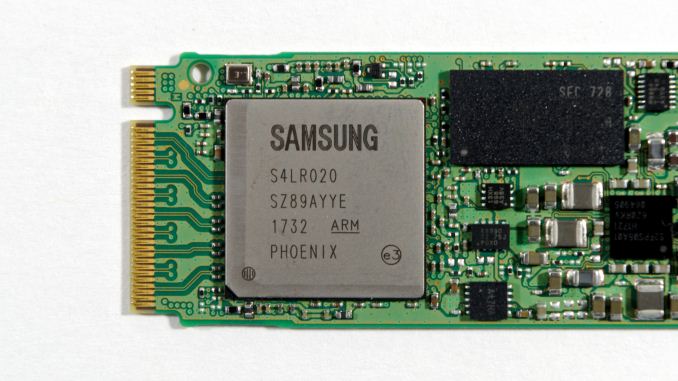
Samsung’s retail NVMe SSDs, like the 960 PRO, are well-known as some of the fastest SSDs for consumers, but the release of these consumer drives is usually preceded by OEM drives based on similar technology. For example, the 960 Pro is almost identical to the SM961, and the 950 Pro is based on the same controller found in the SM951. The 971 client series was for BGA SSDs, so for the next generation consumer drives, Samsung is expected to use the PM981 controller and NAND as a base for the design. Luckily, the PM981 is the subject of this review.
The Samsung PM981 is Samsung’s fourth-generation client PCIe SSD, based on the Phoenix controller and 64-layer V-NAND – both of which have yet to show up in Samsung’s retail NVMe SSDs. The PM981 offers both a preview of Samsung’s next generation retail NVMe SSDs, and a look at what will likely be the fastest storage available in a high-end notebook computer for the next year.
The Samsung Phoenix NVMe controller has been making appearances at trade shows all year, mostly in the new hot-swappable enterprise form factor PM983 enterprise SSD that Samsung has been promoting for high density solid state storage. Little has been disclosed about this controller other than its name, Phoenix, but it seems to be an incremental evolution of Samsung’s client and low-end enterprise SSD controller architecture. With roughly the same package size as the previous generation Samsung Polaris controller, the Phoenix likely retains the same basic configuration of PCIe lanes and NAND and DRAM channels. When Samsung announces retail products based on this controller we should be able to get some information about what’s changed internally to allow for improved performance, but for now, even with our testing, we can only speculate. It is clear that Samsung is taking cooling more seriously this time around with a metal heatspreader on top of the package, similar to what i’s used on the Silicon Motion SM2260 controller. Samsung has previously used copper foil in the drive stickers to help dissipate heat, so this marks a step up in attempting to cool the controller. Other M.2 PCIe SSD vendors have used that tactic and many have also released drives with more substantial heatspreaders or heatsinks in the future.
The 64-layer 3D TLC NAND Samsung uses in the PM981 has been gradually rolling out across their product lines this year, starting with the Portable SSD T5. Earlier this week we took a look at the Samsung SSD 850 120GB, a new model SATA drive that has been released in the Asian market. The SSD 850 also incorporates the 64-layer 3D TLC, but the small drive capacity and SATA interface were both limiting the extent to which we could measure the performance improvements the new NAND enables.

256GB Package with 8 dies of 64L TLC V-NAND
With a per-die capacity of 256Gb (32GB), it is not that much of a challenge for Samsung to make the 1TB PM981 a single-sided drive by stacking each of the packages with 16 NAND chips each. The 512GB model uses 8-high stacks and is about 0.4mm thinner as a result. The model number stenciled in the circuit board indicates that Samsung does not plan to use this layout for anything larger than 1TB, so if a 2TB model shows up it will probably use a denser layout of four packages rather than switch to 512Gb NAND dies.
| Samsung OEM Client PCIe SSD History | ||||
| Controller | NAND Flash | Notes | Consumer Variant |
|
| XP941 | S4LN053X01 | 2D MLC | PCIe 2.0, AHCI | – |
| SM951 | UBX | 2D MLC | AHCI or NVMe | 950 PRO |
| PM951 | 2D TLC | – | ||
| SM961 | Polaris | 2D & 3D MLC | 960 PRO | |
| PM961 | 3D TLC | 960 EVO | ||
| PM971 | Photon | 3D TLC | BGA SSD, PCIe 3 x2 | – |
| PM981 | Phoenix | 3D TLC | 980 Evo? | |
Samsung’s OEM client PCIe SSDs are usually not an exact match for the retail products of the same generation. Their first-generation XP941 used a PCIe 2.0 interface with AHCI instead of NVMe, and never got a retail counterpart. The SM951 and PM951 used planar MLC and TLC respectively, while the later 950 PRO used Samsung’s 3D MLC NAND. The SM961 also seems to use planar MLC for its smaller capacities, though the TLC-based PM961 is entirely based on 3D NAND. The Samsung PM971 is an entry-level BGA SSD that may not get a retail counterpart, and if it does it will not fit into either of the existing 9×0 PRO/EVO product tiers.
Based on the model number, the PM981 could be expected to serve as a preview of a 980 EVO product. However, every SSD Samsung has moved to 64-layer V-NAND has used TLC—even the high-end enterprise SSDs. With Samsung’s Z-NAND covering the high-performance low-latency niche, Samsung may retire the use of MLC NAND from their more mainstream product lines. If Samsung is not planning to release an enthusiast-oriented Z-NAND product, then the PM981’s retail counterpart may have to serve as successor to both the 960 EVO and 960 PRO.
For this review, the primary comparisons will be against the Samsung 960 PRO and 960 EVO, the closest retail equivalents to Samsung’s previous generation of client PCIe SSDs. Results for many other PCIe SSDs and a few SATA SSDs are included for comparison. Power measurements are still missing due to a recent equipment failure, but new and much better SSD power measurement equipment is on the way.
| AnandTech 2017 SSD Testbed | |
| CPU | Intel Xeon E3 1240 v5 |
| Motherboard | ASRock Fatal1ty E3V5 Performance Gaming/OC |
| Chipset | Intel C232 |
| Memory | 4x 8GB G.SKILL Ripjaws DDR4-2400 CL15 |
| Graphics | AMD Radeon HD 5450, 1920×1200@60Hz |
| Software | Windows 10 x64, version 1703 |
| Linux kernel version 4.12, fio version 2.21 | |
- Thanks to Intel for the Xeon E3 1240 v5 CPU
- Thanks to ASRock for the E3V5 Performance Gaming/OC
- Thanks to G.SKILL for the Ripjaws DDR4-2400 RAM
- Thanks to Corsair for the RM750 power supply, Carbide 200R case, and Hydro H60 CPU cooler
The Destroyer is an extremely long test replicating the access patterns of very IO-intensive desktop usage. A detailed breakdown can be found in this article. Like real-world usage, the drives do get the occasional break that allows for some background garbage collection and flushing caches, but those idle times are limited to 25ms so that it doesn’t take all week to run the test. These AnandTech Storage Bench (ATSB) tests do not involve running the actual applications that generated the workloads, so the scores are relatively insensitive to changes in CPU performance and RAM from our new testbed, but the jump to a newer version of Windows and the newer storage drivers can have an impact.
We quantify performance on this test by reporting the drive’s average data throughput, the average latency of the I/O operations, and the total energy used by the drive over the course of the test.

The average data rate of the 1TB Samsung PM981 on The Destroyer is comparable to the 960 EVO 1TB and well ahead of any competing TLC-based drives like the Toshiba XG5. The 512GB PM981 is slower by a typical amount, and still faster than any of the non-Samsung drives of that size.


The 1TB PM981 shows a substantial improvement over the average and 99th percentile latency scores of the 960 EVO, putting it close to the 960 PRO. The 512GB PM981 isn’t as impressive, with latency scores that fall behind most MLC-based NVMe SSDs.


The 1TB PM981 sets a new record (among flash-based SSDs) for average read latency on The Destroyer, shaving a few microseconds off the 960 PRO’s performance. The average write latency can’t quite keep up with the MLC-based 960 PRO that doesn’t use SLC write caching. The smaller 512GB PM981 is competitive with most similarly-sized MLC-based drives, but slower than Samsung’s 960 PRO.


Samsung’s 99th percentile read latency is nothing special, though the PM981 does offer clear improvement over the 960 EVO. The 99th percentile write latency of the 1TB PM981 is excellent and far better than the 1TB 960 EVO. The 512GB PM981 is clearly the fastest TLC-based drive of that size that we’ve tested, but it doesn’t quite match the 99th percentile latency scores of the MLC-based competition.
Our Heavy storage benchmark is proportionally more write-heavy than The Destroyer, but much shorter overall. The total writes in the Heavy test aren’t enough to fill the drive, so performance never drops down to steady state. This test is far more representative of a power user’s day to day usage, and is heavily influenced by the drive’s peak performance. The Heavy workload test details can be found here. This test is run twice, once on a freshly erased drive and once after filling the drive with sequential writes.

On the Heavy test, the average data rates of the 512GB Samsung PM981 again lag slightly behind most MLC-based NVMe drives but are clearly ahead of the competitors’ TLC drives. The 1TB PM981 is behaving a bit oddly with slower than expected performance after a secure erase, but great performance when filled.


The average latency of the 1TB PM981 is a significant improvement over the 1TB 960 EVO, while the 512GB PM981 doesn’t stand out from the other 512GB drives. The 99th percentile latencies aren’t particularly good, and the 512GB PM981 scores worse than almost all the other PCIe SSDs of that size.


The average write latency of the 1TB PM981 is excellent especially when the test is run on an empty drive. Average read latencies for both drives are decent but aren’t a big improvement over their predecessors.


The 99th percentile read latencies are one of the few ATSB scores where the TLC-based nature of the PM981 shines through. Many MLC-based SSDs are much better at keeping read latency under control, and the TLC-based Toshiba XG5 also scores much better than the PM981 here. The 99th percentile write latency of the 1TB PM981 is pretty good, following suit to the average write latency, while the 512GB model could use some improvement.
Our Light storage test has relatively more sequential accesses and lower queue depths than The Destroyer or the Heavy test, and it’s by far the shortest test overall. It’s based largely on applications that aren’t highly dependent on storage performance, so this is a test more of application launch times and file load times. This test can be seen as the sum of all the little delays in daily usage, but with the idle times trimmed to 25ms it takes less than half an hour to run. Details of the Light test can be found here. As with the ATSB Heavy test, this test is run with the drive both freshly erased and empty, and after filling the drive with sequential writes.

Both capacities of the Samsung PM981 offer great average data rates on the Light test. Their performance when full or empty is improved over the Samsung 960 EVO and comes close to the 960 PRO.


The average and 99th percentile latency scores of the PM981s aren’t much of an improvement over Samsung’s last generation, but this is still a new record for flash-based SSDs, even though the PM981 is using TLC NAND.


The average write latency of the PM981s is great whether the test is run on a full or empty drive, but the average read latency is slightly worse than the 960 PRO when the test is run on a full drive.


The 99th percentile read latency of the PM981s is record-setting when the Light test is run on an empty drive, but only the 1TB sets a record when the test is run on a full drive. The 99th percentile write latency is excellent on both drives in either test scenario.
Our first test of random read performance uses very short bursts of operations issued one at a time with no queuing. The drives are given enough idle time between bursts to yield an overall duty cycle of 20%, so thermal throttling is impossible. Each burst consists of a total of 32MB of 4kB random reads, from a 16GB span of the disk. The total data read is 1GB.

The burst random read performance of the Samsung PM981 is great by the standards of TLC SSDs, but is surpassed by several MLC-based drives, including the Phison E7-based Patriot Hellfire with planar MLC NAND.
Our sustained random read performance is similar to the random read test from our 2015 test suite: queue depths from 1 to 32 are tested, and the average performance and power efficiency across QD1, QD2 and QD4 are reported as the primary scores. Each queue depth is tested for one minute or 32GB of data transferred, whichever is shorter. After each queue depth is tested, the drive is given up to one minute to cool off so that the higher queue depths are unlikely to be affected by accumulated heat build-up. The individual read operations are again 4kB, and cover a 64GB span of the drive.

On the longer random read test that includes some higher queue depths, the PM981 comes a bit closer to the standard set by Samsung’s MLC drives, and it outperforms all the non-Samsung drives.
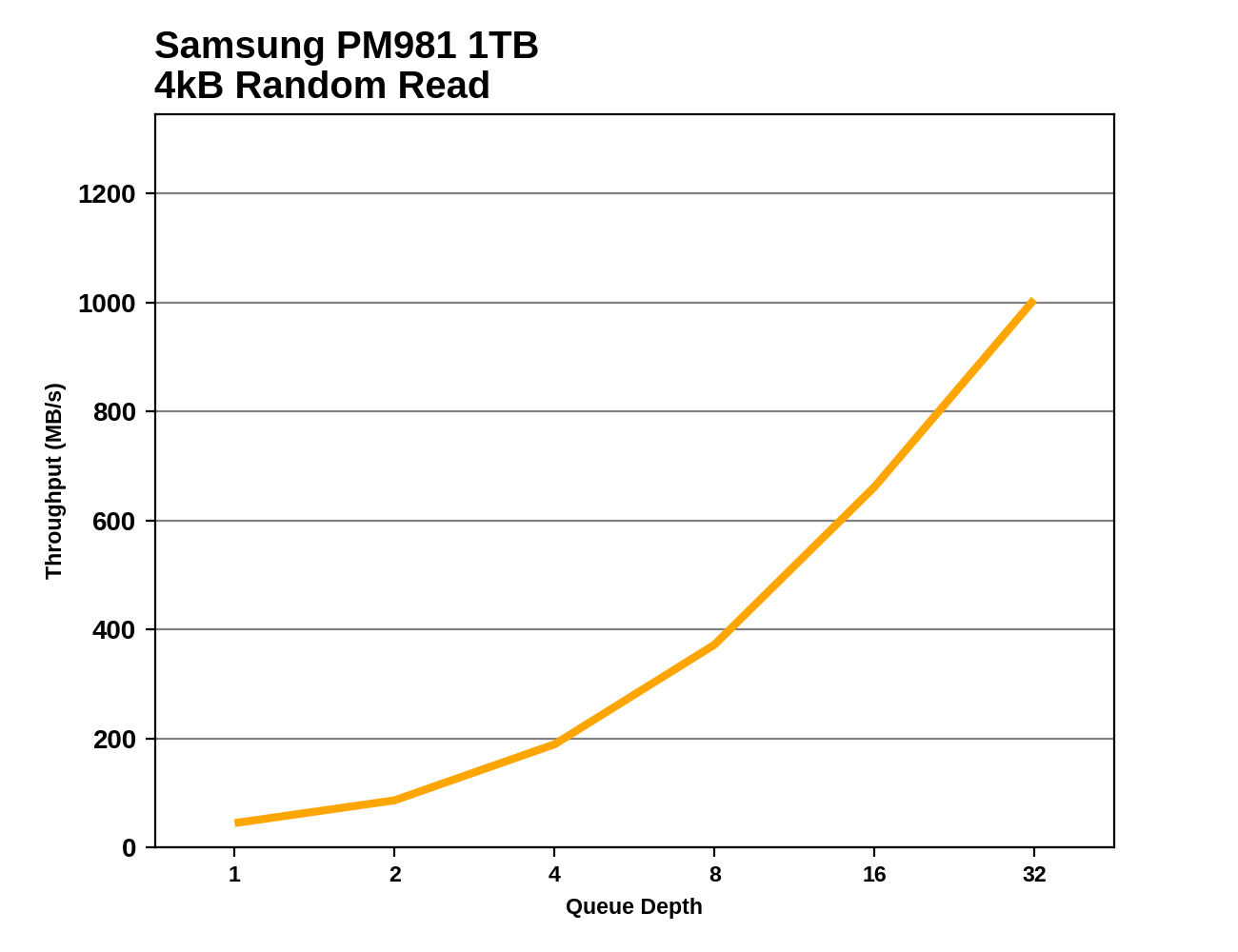 |
|||||||||
Both capacities of the PM981 show performance scaling with queue depth in the typical manner for a high-performance drive, though the 512GB model has passed an inflection point by QD32 and is approaching saturation.
Our test of random write burst performance is structured similarly to the random read burst test, but each burst is only 4MB and the total test length is 128MB. The 4kB random write operations are distributed over a 16GB span of the drive, and the operations are issued one at a time with no queuing.

There are a few MLC-based SSDs that offer substantially higher burst random write performance than the Samsung PM981, but it is on par with most high-end drives including the Samsung 960 PRO.
As with the sustained random read test, our sustained 4kB random write test runs for up to one minute or 32GB per queue depth, covering a 64GB span of the drive and giving the drive up to 1 minute of idle time between queue depths to allow for write caches to be flushed and for the drive to cool down.

On the longer random write test, the 1TB PM981 stands out with clearly higher performance than the Samsung 960 series could manage. The 512GB PM981 is slower but still definitely performing like a high-end drive.
 |
|||||||||
The random write performance of the 1TB PM981 scales very well with increasing queue depth. As compared to the Samsung 960 series, it also reaches its plateau around QD8, but is providing much higher throughput by that point. The 512GB model runs out of SLC cache during portions of this test so its performance is much lower and less steady.
Our first test of sequential read performance uses short bursts of 128MB, issued as 128kB operations with no queuing. The test averages performance across eight bursts for a total of 1GB of data transferred from a drive containing 16GB of data. Between each burst the drive is given enough idle time to keep the overall duty cycle at 20%.

The burst sequential read performance of the Samsung PM981 doesn’t quite set a new record, but it’s pretty close to the top performer and very far ahead of any non-Samsung drive.
Our test of sustained sequential reads uses queue depths from 1 to 32, with the performance and power scores computed as the average of QD1, QD2 and QD4. Each queue depth is tested for up to one minute or 32GB transferred, from a drive containing 64GB of data.

On the longer test with higher queue depths, the best MLC-based drives pull ahead of the PM981 and even the 960 EVO has a slight advantage.
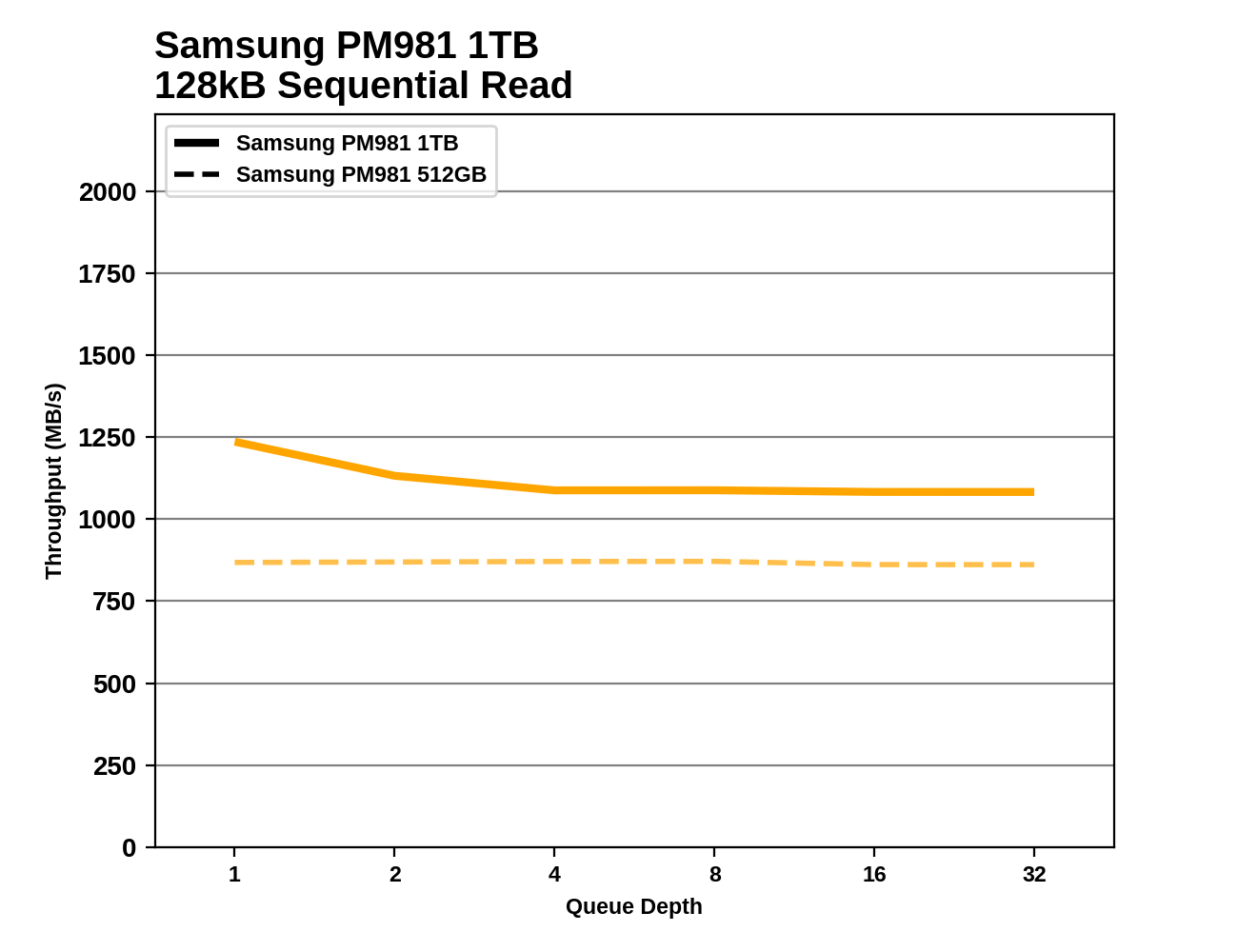 |
|||||||||
The 1TB PM981 starts out with almost the same performance as the 1TB 960 EVO, but the PM981’s performance falls off a bit during the first half of the test while the 960 EVO remains steady. The 512GB PM981 doesn’t experience any slowdown, but it is slower than the 1TB model throughout the test.
Our test of sequential write burst performance is structured identically to the sequential read burst performance test save for the direction of the data transfer. Each burst writes 128MB as 128kB operations issued at QD1, for a total of 1GB of data written to a drive containing 16GB of data.

The PM981s both deliver the same record-setting burst sequential write performance that is a marked improvement over the best of Samsung’s last generation, and far ahead of any competing flash-based SSD.
Our test of sustained sequential writes is structured identically to our sustained sequential read test, save for the direction of the data transfers. Queue depths range from 1 to 32 and each queue depth is tested for up to one minute or 32GB, followed by up to one minute of idle time for the drive to cool off and perform garbage collection. The test is confined to a 64GB span of the drive.

On the longer sequential write test, the 512GB PM981 falls behind most of the rest of the Samsung drives but the 1TB model remains on top, ahead of even the 960 PROs.
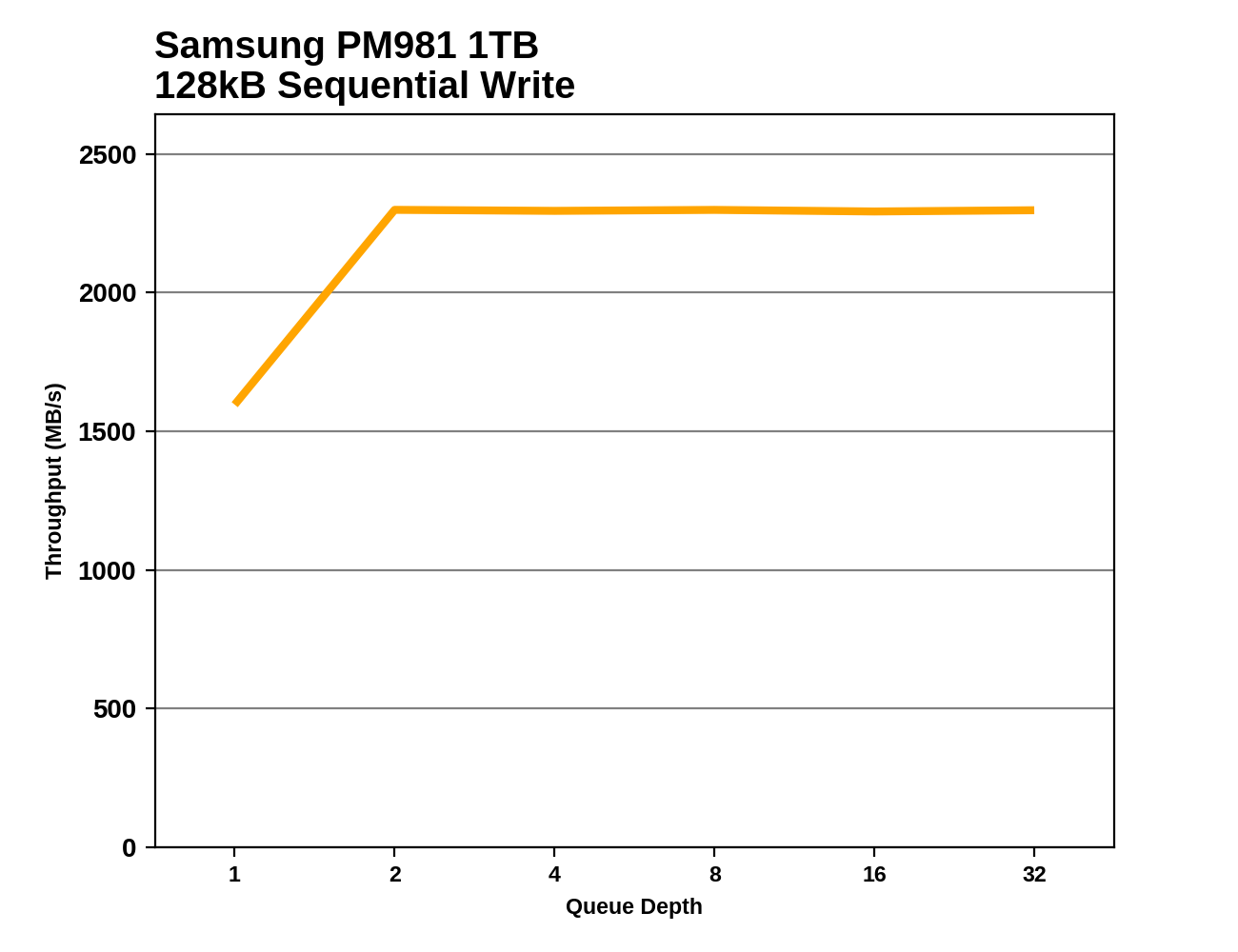 |
|||||||||
The 1TB PM981 hits full write speed at QD2 and stays there for the rest of the test, holding on to its lead over the 960 PRO. The 512GB PM981 runs out of SLC write cache early on and its performance bounces around with the garbage collection cycles.
Our test of mixed random reads and writes covers mixes varying from pure reads to pure writes at 10% increments. Each mix is tested for up to 1 minute or 32GB of data transferred. The test is conducted with a queue depth of 4, and is limited to a 64GB span of the drive. In between each mix, the drive is given idle time of up to one minute so that the overall duty cycle is 50%.

The mixed random I/O performance of the Samsung PM981 is a big improvement over last generation’s 960 EVO. The 1TB PM981 beats out even the MLC-based 960 PRO, while the smaller 512GB PM981 is a bit slower than the 960 PRO of the same size.
 |
|||||||||
As the proportion of writes in the mixed workload increases, the PM981 steadily gains performance, pulling further and further ahead of the 960 EVO. The 512GB PM981’s main weakness is that its performance doesn’t hit quit as high a peak during the final phases of the test when the workload is almost entirely random writes.
Our test of mixed sequential reads and writes differs from the mixed random I/O test by performing 128kB sequential accesses rather than 4kB accesses at random locations, and the sequential test is conducted at queue depth 1. The range of mixes tested is the same, and the timing and limits on data transfers are also the same as above.

The 512GB PM981 matches the mixed sequential performance of the MLC-based 512GB 960 PRO, while the 1TB PM981 is substantially faster than the 960 PRO or any other flash-based SSD.
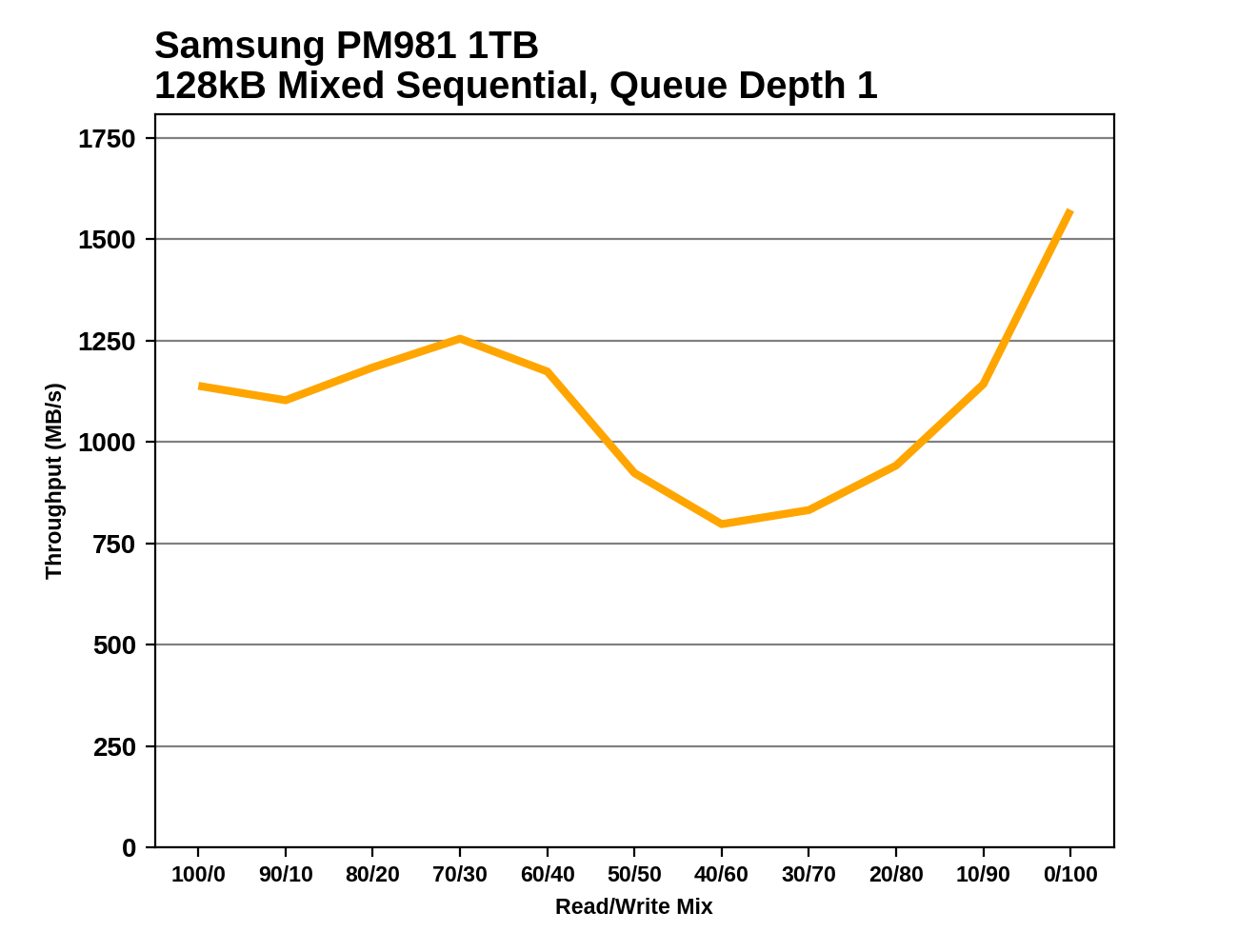 |
|||||||||
The Samsung 960 PRO 1TB outperforms the 1TB PM981 during the early read-heavy phases of the mixed sequential test, but then its performance drops off precipitously while the PM981 retains its performance until later in the test. The 512GB PM981 averages almost exactly the same performance as the 512GB 960 PRO, but with substantial differences in the details: the 960 PRO is faster at either end of the test, but the PM981 has a significant advantage for more even mixes of reads and writes.
The Samsung PM981 looks poised to sit as a potential base for a 980 Evo equivalent in 2018. It offers a healthy generational improvement to performance due to the combination of a new controller and Samsung’s new 64-layer 3D TLC NAND. The previous generation (PM961 for OEMs, 960 EVO for retail) was already the fastest TLC-based client SSD, and it outperforms many MLC-based SSDs. By improving on that level of performance, the PM981 has caught up to or surpassed the MLC-based 96x drives on many tests, setting new records not just for TLC-based drives but for client SSDs as a whole.
The Samsung PM981 offers performance that is more well-rounded than any other TLC-based SSD. The faster 1TB capacity is almost completely immune to the typical pitfalls of using TLC NAND; it is almost impossible for a real-world workload to trigger the kind of nasty slowdown that typically indicates a full SLC write cache or something else causing a lot of background work for the SSD controller.
The 512GB PM981 doesn’t set records except for within its own product class, but it too is a meaningful improvement over its predecessors. The 512GB model doesn’t handle heavy workloads quite as well as the larger model, but it still beats any other TLC-based option.
Both drives raise the bar for how well TLC SSDs should perform. On lighter workloads, they set a new standard that even MLC-based drives have trouble reaching. For almost everyone, the fact that the PM981 uses TLC NAND is no cause for concern because the performance defies the expectations for TLC SSDs. They are obviously great choices for OEMs to offer in high-performing notebook computers, depending on the power consumption, which we will test when our testing equipment is fixed.
Enthusiasts will have to wait until CES in January or some later event to hear about Samsung’s next SSDs based on the PM981, which is likely to be called the 980 Evo if it follows previous naming conventions. These PM981 drives, if you can source them on the grey market, may be a reasonable choice for impatient system builders wanting to put the latest TLC into their systems today. As always though, OEM drives purchased on the grey market come with no warranty from the manufacturer and firmware updates may be hard to come by, so they aren’t for everyone.

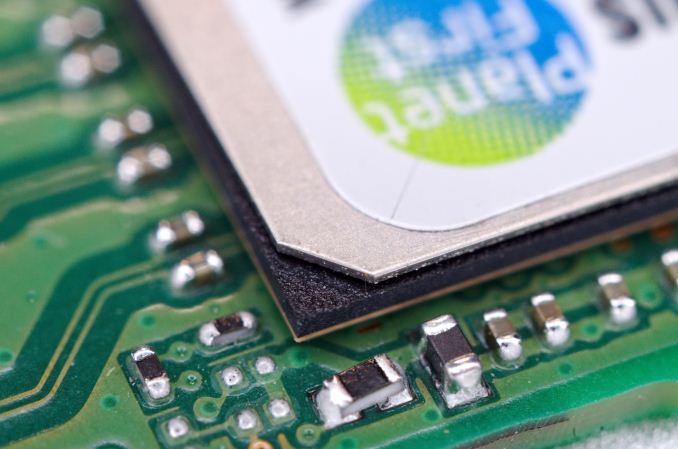






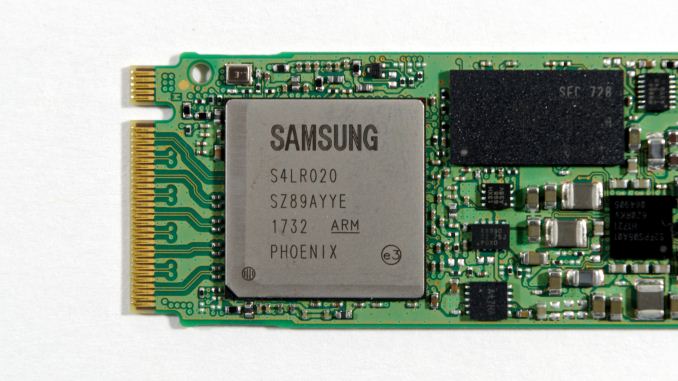
Una risposta su “Samsung PM981 SSD Review (512GB, 1TB): Next Generation Controller And 3D NAND”
I was looking for the components for our project and Samsung is pretty good at keeping things tight. Cannot find k9UUGY8 Chips used in SM961 1TB drives anywhere. We ended up buying the SM961 to farm the chips.
No supplier for LGA60 256GB and the 110 LGA chip (iPhone Xs NAND) 1TB chip also no avail to consumers. We may have to farm the SM961 or if point out the source we can buy a few each from the distributor will be awesome.